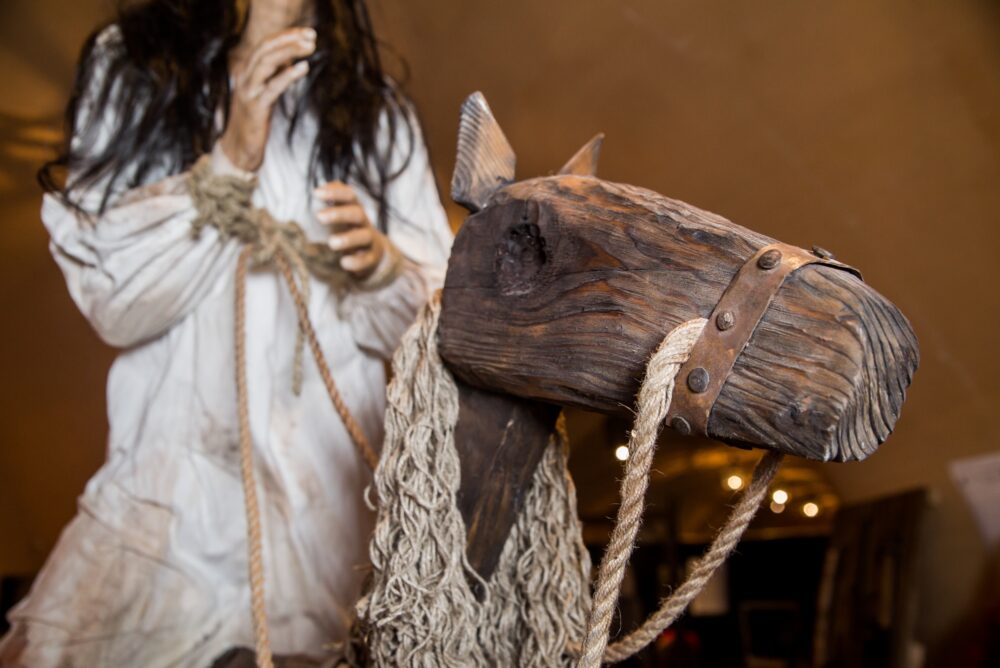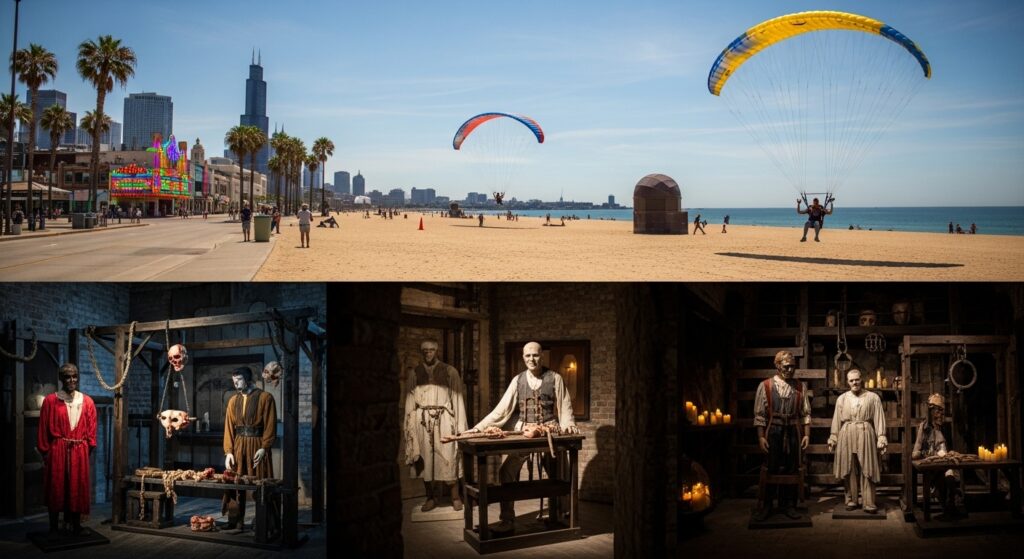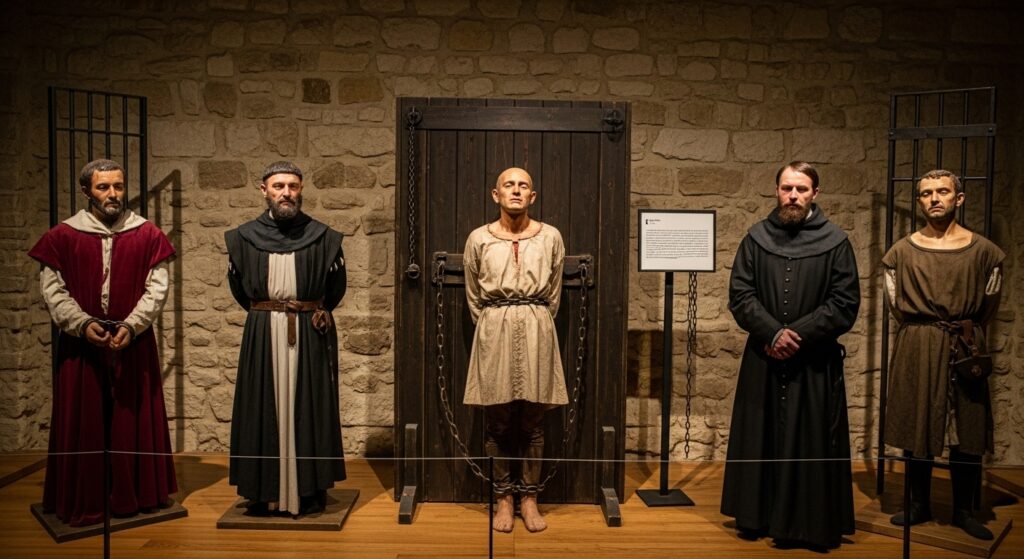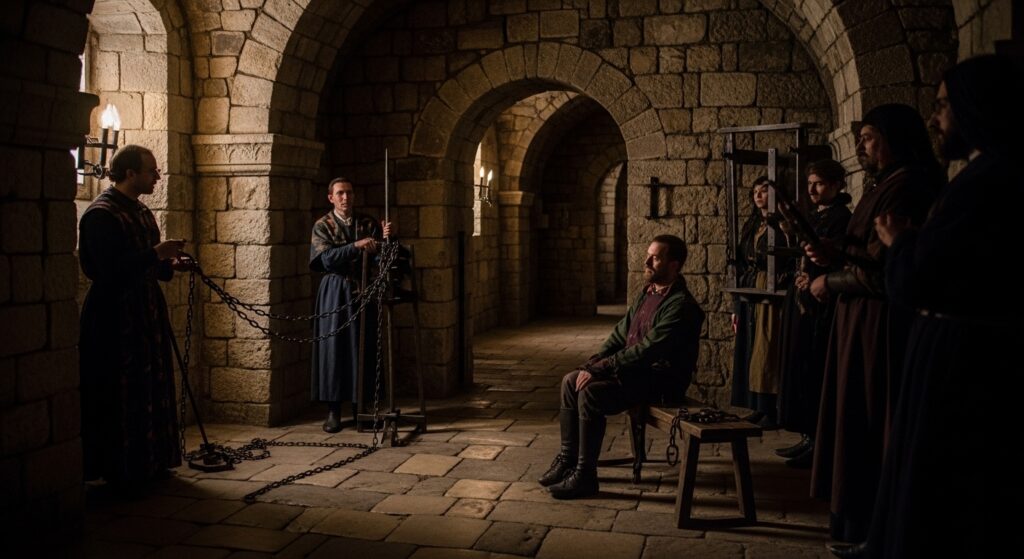The Inquisition remains one of the darkest periods in the history of religion, casting a long shadow over the relationship between faith and cruelty. Throughout the Middle Ages, the Inquisition aimed to root out heresy through pain and suffering, leading to the development of notorious torture methods. These brutal techniques were designed to extract confessions and force individuals to renounce their beliefs. The role of torture in medieval religion was deeply embedded in the ideology that pain could purify the soul, allowing the Church to maintain control over society.
For those interested in discovering more about these grim practices, the Medieval Torture Museum in LA offers a unique chance to explore the chilling artifacts and stories left behind by this era. It is one of the most unique things to do in St. Augustine, allowing visitors to step into the dark past of religious enforcement.
The Inquisition’s Use of Torture
During the Middle Ages, the Church employed various torture devices to break the will of accused heretics. These gruesome medieval torture methods were cruel and often prolonged, ensuring maximum pain. The torture devices in the Inquisition were not meant to kill immediately but rather to inflict immense suffering, allowing time for confessions and repentance.
Some of the most infamous inquisition tools of torture include:
- The Rack: A device used to slowly stretch the body, often dislocating the limbs.
- The Iron Maiden: A coffin-like structure lined with spikes that would slowly impale the victim.
- The Strappado: Victims were hung by their wrists, causing intense pain in the shoulders.
- The Thumb Screw: A device designed to crush the fingers and induce excruciating pain.
These tools were part of a systematic effort to maintain religious control. They are prominently displayed in exhibits at museums dedicated to the legacy of medieval torture, offering a stark reminder of the human capacity for cruelty.
Torture and Punishment in the Middle Ages
The torture and punishment in the Middle Ages extended beyond religious enforcement. The methods employed during this period were often based on outdated legal practices that used pain as a form of control and justice. Punishment was a public spectacle, reinforcing the power of the ruling class or the Church over the common people. Torture became a ritualized aspect of law enforcement, deeply intertwined with faith and religious ideology.
For example, medieval society believed that torture methods of the Inquisition could cleanse a person’s soul from heresy. The tortured were often left broken in body but supposedly cleansed in spirit. This belief cemented the connection between faith and pain, where suffering was seen as a necessary path to salvation. Visitors can see reconstructions of these methods in museums today, such as the Medieval Torture Museum in Chicago, one of the must-see in St. Augustine and other cities that preserve the heritage of this grim past.
The Influence of Religion on Torture Methods
The role of torture in medieval religion cannot be overstated. The belief that pain purified the soul was used as a justification for the Church’s involvement in state affairs, allowing them to use horrific methods without moral repercussions. These rituals of pain and suffering became deeply ingrained in religious practices, demonstrating the Church’s absolute authority over both body and soul.
The concept of “redemptive suffering” was central to the medieval understanding of justice. Torture was not only a tool of enforcement but also a way to bring the accused closer to salvation. This idea reinforced the notion that cruelty could serve a higher purpose, shaping the brutal enforcement of religious orthodoxy during the Inquisition.
Modern Exhibits of Medieval Torture Devices
Today, the chilling legacy of the torture devices in the Inquisition can be explored at various museums around the world. These exhibits serve as a stark reminder of the cruelty inflicted in the name of religion. The gruesome medieval torture methods showcased in museums offer a unique window into the past, allowing visitors to experience history up close.
For those looking for things to do in Saint Augustine, the Medieval Torture Museum offers a comprehensive look into these medieval torture practices. The tools used during the Inquisition are carefully displayed, giving insight into the dark methods used to enforce religious orthodoxy.
In addition, the Medieval Torture Museum in Chicago provides an equally immersive experience. Visitors can explore a variety of torture devices from the medieval period, many of which were employed to punish those deemed enemies of the Church.
The Legacy of Torture in Religion
The heritage of torture in religious enforcement is one that continues to haunt modern societies. The Inquisition tools of torture serve as a grim reminder of how easily faith can be twisted to justify cruelty. These practices, once considered essential to maintaining religious purity, have left an indelible mark on the world’s understanding of pain, punishment, and justice.
The gruesome medieval torture methods have been immortalized in museums, where the public can explore these terrifying devices and reflect on the dark side of human history. If you’re interested in learning more about this legacy, check out our blog, which delves deeper into the complex relationship between religion and torture in medieval times.
Conclusion
The Inquisition’s Dark Legacy continues to fascinate and horrify those who delve into its history. The use of torture methods of the Inquisition not only enforced religious orthodoxy but also shaped the medieval worldview of justice and faith. Today, we can explore the remnants of this dark period in museums that carefully preserve and display the torture devices and methods used during the Middle Ages.
For anyone seeking a must-see in Saint Augustine, the Medieval Torture Museum is an experience like no other. It offers a haunting journey into the past, where torture and punishment were part of the everyday fabric of life. Whether visiting the Medieval Torture Museum in LA or the Medieval Torture Museum in Chicago, these exhibits serve as a stark reminder of how faith, power, and cruelty once converged.
Explore the heritage of medieval torture and reflect on the dark history that has shaped our modern understanding of religion and justice.







